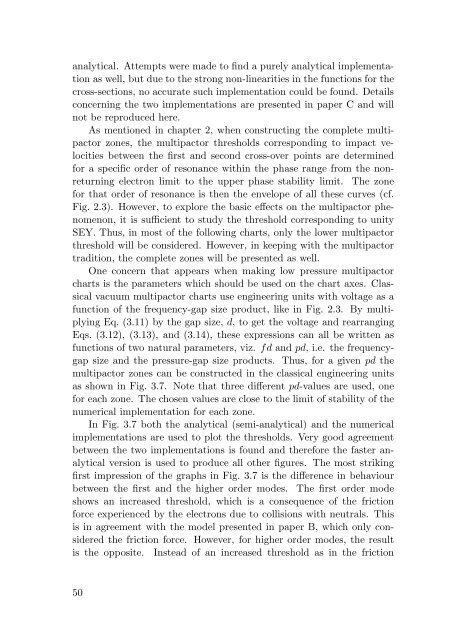Multipactor in Low Pressure Gas and in ... - of Richard Udiljak
Multipactor in Low Pressure Gas and in ... - of Richard Udiljak
Multipactor in Low Pressure Gas and in ... - of Richard Udiljak
Create successful ePaper yourself
Turn your PDF publications into a flip-book with our unique Google optimized e-Paper software.
analytical. Attempts were made to f<strong>in</strong>d a purely analytical implementation<br />
as well, but due to the strong non-l<strong>in</strong>earities <strong>in</strong> the functions for the<br />
cross-sections, no accurate such implementation could be found. Details<br />
concern<strong>in</strong>g the two implementations are presented <strong>in</strong> paper C <strong>and</strong> will<br />
not be reproduced here.<br />
As mentioned <strong>in</strong> chapter 2, when construct<strong>in</strong>g the complete multipactor<br />
zones, the multipactor thresholds correspond<strong>in</strong>g to impact velocities<br />
between the first <strong>and</strong> second cross-over po<strong>in</strong>ts are determ<strong>in</strong>ed<br />
for a specific order <strong>of</strong> resonance with<strong>in</strong> the phase range from the nonreturn<strong>in</strong>g<br />
electron limit to the upper phase stability limit. The zone<br />
for that order <strong>of</strong> resonance is then the envelope <strong>of</strong> all these curves (cf.<br />
Fig. 2.3). However, to explore the basic effects on the multipactor phenomenon,<br />
it is sufficient to study the threshold correspond<strong>in</strong>g to unity<br />
SEY. Thus, <strong>in</strong> most <strong>of</strong> the follow<strong>in</strong>g charts, only the lower multipactor<br />
threshold will be considered. However, <strong>in</strong> keep<strong>in</strong>g with the multipactor<br />
tradition, the complete zones will be presented as well.<br />
One concern that appears when mak<strong>in</strong>g low pressure multipactor<br />
charts is the parameters which should be used on the chart axes. Classical<br />
vacuum multipactor charts use eng<strong>in</strong>eer<strong>in</strong>g units with voltage as a<br />
function <strong>of</strong> the frequency-gap size product, like <strong>in</strong> Fig. 2.3. By multiply<strong>in</strong>g<br />
Eq. (3.11) by the gap size, d, to get the voltage <strong>and</strong> rearrang<strong>in</strong>g<br />
Eqs. (3.12), (3.13), <strong>and</strong> (3.14), these expressions can all be written as<br />
functions <strong>of</strong> two natural parameters, viz. fd <strong>and</strong> pd, i.e. the frequencygap<br />
size <strong>and</strong> the pressure-gap size products. Thus, for a given pd the<br />
multipactor zones can be constructed <strong>in</strong> the classical eng<strong>in</strong>eer<strong>in</strong>g units<br />
as shown <strong>in</strong> Fig. 3.7. Note that three different pd-values are used, one<br />
for each zone. The chosen values are close to the limit <strong>of</strong> stability <strong>of</strong> the<br />
numerical implementation for each zone.<br />
In Fig. 3.7 both the analytical (semi-analytical) <strong>and</strong> the numerical<br />
implementations are used to plot the thresholds. Very good agreement<br />
between the two implementations is found <strong>and</strong> therefore the faster analytical<br />
version is used to produce all other figures. The most strik<strong>in</strong>g<br />
first impression <strong>of</strong> the graphs <strong>in</strong> Fig. 3.7 is the difference <strong>in</strong> behaviour<br />
between the first <strong>and</strong> the higher order modes. The first order mode<br />
shows an <strong>in</strong>creased threshold, which is a consequence <strong>of</strong> the friction<br />
force experienced by the electrons due to collisions with neutrals. This<br />
is <strong>in</strong> agreement with the model presented <strong>in</strong> paper B, which only considered<br />
the friction force. However, for higher order modes, the result<br />
is the opposite. Instead <strong>of</strong> an <strong>in</strong>creased threshold as <strong>in</strong> the friction<br />
50


